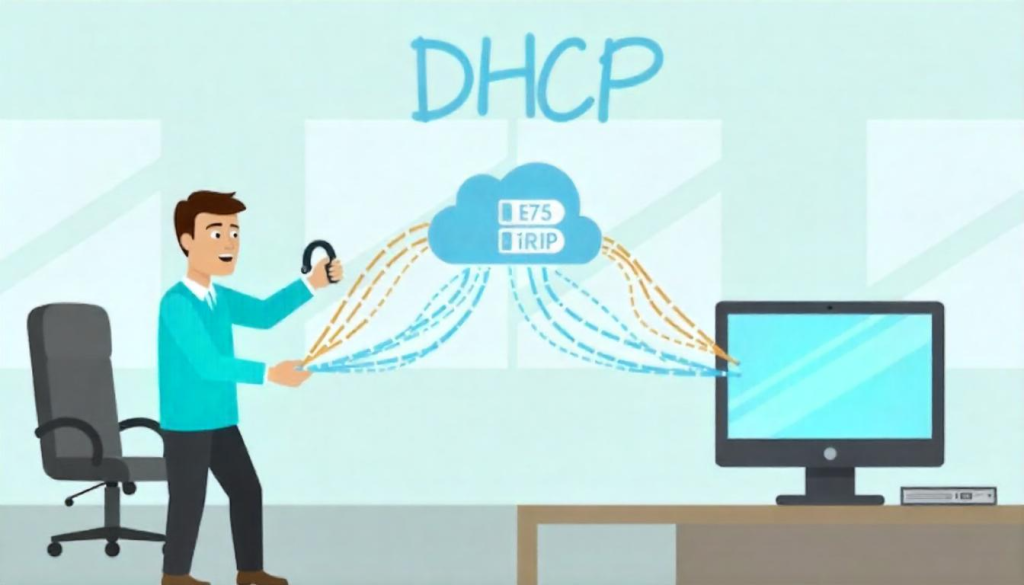Ever walked into a café, tapped into the Wi-Fi, and—boom—you’re online in seconds? No setup, no fuss. Or maybe your new laptop connected to your home network like it had lived there forever. Feels like magic, right? While it’s not sorcery, there is some clever tech at play: a behind-the-scenes protocol called DHCP—short for Dynamic Host Configuration Protocol.

Think of DHCP as the friendly concierge of your digital world. Its job? To hand out unique addresses—called IP addresses—to every device that joins a network. Just like every home needs an address to receive mail, every device needs an IP to send and receive data.
Let’s unravel how this essential system works in plain English.
Why Do We Even Need DHCP? 🧐
Picture a small office with three or four computers. You could manually assign an IP address to each one—this is called static IP addressing. It’s doable on a tiny scale.
Now scale that up. Think big: schools, corporations, smart homes, coffee shops with 50 guests on Wi-Fi. Manually assigning addresses? That would be chaos. Here’s why:
-
Each address has to be unique.
-
Moving devices to different networks would mean reconfiguring them.
-
Someone would have to track which addresses are taken.
-
If settings change (like a new router), devices would need to be updated.
Enter DHCP: a fully automated system that handles all of that in the background, letting devices join the network effortlessly. No manual setup needed. 🎯
Meet the DHCP Duo: Server & Client 🤖📱
There are two key players in the DHCP story:
-
DHCP Server: This could be your Wi-Fi router at home or a specialized server in an enterprise. It holds a stash of IP addresses and configuration data.
-
DHCP Client: This is any device trying to get online—your phone, laptop, smart fridge, or gaming console.
The Four-Step DHCP Dance: D-O-R-A 💃
When a device joins a network, it goes through a four-part interaction often remembered as DORA:
-
Discover – The device says: “Is there a DHCP server out there?”
-
Offer – The server replies: “Here’s an IP address you can use.”
-
Request – The device responds: “I’d like that IP, please.”
-
Acknowledge – The server confirms: “You got it!”
Let’s look closer:
1. DHCP Discover 📣
When your device connects, it has no IP address. So it sends a DHCPDISCOVER broadcast on the network—basically shouting, “Can anyone assign me an IP?”
2. DHCP Offer 💌
Any DHCP server that hears this sends back a DHCPOFFER, which includes:
-
The suggested IP address
-
The subnet mask
-
The lease time (how long you can use it)
-
DNS and gateway info
The client usually grabs the first offer that arrives.
3. DHCP Request 📨
The device sends a DHCPREQUEST to the server that made the offer, confirming, “Yes, I’ll take that IP!” It’s also a polite way to let other servers know, “Thanks, but no thanks.”
4. DHCP Acknowledge ✅
The server replies with a DHCPACK, sealing the deal. The device is now officially on the network—with everything it needs to communicate and surf the web.
Leases: You Don’t Keep the IP Forever ⏳
The IP address you get isn’t yours forever. It’s leased for a set amount of time. This has perks:
-
Recycling: If a device disconnects, the IP can be reused.
-
Flexibility: If network settings change, updated info can be sent during lease renewal.
Here’s how it works:
-
At 50% of the lease time, the device tries to quietly renew the lease.
-
At 87.5%, if it hasn’t succeeded, it broadcasts a request hoping any DHCP server will respond.
-
If no one replies and the lease fully expires, the device drops the IP and restarts the DORA process.
When Things Go Sideways 🚨
Not every DHCP interaction goes smoothly. Here are two exceptions:
-
DHCPNACK: The server says, “Nope, you can’t use that IP” (maybe because it’s invalid or already taken).
-
DHCPDECLINE: The client says, “Wait! Someone else is already using this IP.” Then it starts the DORA cycle again.
What If the Server’s on Another Network? Enter DHCP Relay Agents 🚀
DHCP messages are broadcasts, and broadcasts typically don’t cross subnets or routers. So how do devices reach a DHCP server that’s on a different network?
A DHCP Relay Agent solves this. It picks up the broadcast, wraps it up, and sends it as a unicast directly to the server across the subnet. The response gets relayed back the same way. This allows one centralized DHCP server to serve multiple networks.
Why DHCP Matters (TL;DR) 📌
-
✅ Automatic IP assignment – No manual configs needed
-
✅ Efficient management – Handles hundreds or thousands of devices
-
✅ Scalable – Grows with your network
-
✅ Flexible – Adapts to changes in settings or hardware
-
✅ Reliable – Minimizes errors and IP conflicts
So next time you join Wi-Fi at a friend’s house, hop onto your office network, or connect a smart device at home, remember: it’s not magic—it’s DHCP quietly doing its job behind the scenes, making sure your device gets a digital address in the bustling city of the internet.